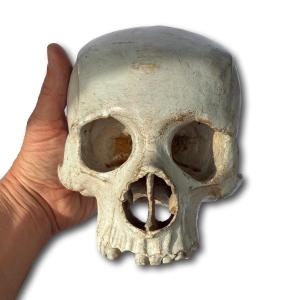Italy, 18th century.
Measurements: 17 × 13 × 12 cm.
A finely carved wooden skull, coated in a pale gesso to simulate the texture and tonality of aged bone. Anatomically faithful and perfectly life-sized, the sculpture captures the hollow orbits, nasal cavity, and dentition with expressive intensity.
Such objects were deeply embedded in the visual and devotional culture of early modern Europe, particularly within the Catholic tradition. Serving as memento mori—literally “remember you must die”—they urged the viewer to reflect upon the inevitability of death and the vanity of worldly attachments. Skulls of this type were often kept in private chapels, cells, or study cabinets, where they functioned as moral prompts in the pursuit of spiritual clarity. Rooted in both monastic meditation and the Baroque sensibility for the theatrical and the transitory, this work stands as a vivid embodiment of vanitas: the reminder that all earthly glory fades.


















































 Le Magazine de PROANTIC
Le Magazine de PROANTIC TRÉSORS Magazine
TRÉSORS Magazine Rivista Artiquariato
Rivista Artiquariato